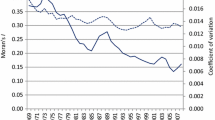Abstract
This paper investigates club convergence in income per capita of 329 prefecture-level city regions in China over a period of 1990 to 2014. A nonlinear time-varying factor model is adopted to examine convergence trends as the model allows for transitional heterogeneity and divergence from the actual growth path. The study further explores the driving forces of convergence clubs using an ordered response model. Four convergence clubs are identified, showing no geographic regularity in club member locations. The highest income club and the lowest income club tend to converge strongly, whereas two middle-income clubs converge weakly. The findings indicate that initial conditions, sectorial characteristics, preferential development policy, general government spending, network effect, spatial effect, and the role of globalization are the significant factors responsible for the formation of club convergence in China.




Similar content being viewed by others
References
Anagnostou A, Kallioras D, Kollias C (2016) Governance convergence among the EU28? Soc Indic Res 129(1):133–146
Apergis N, Cooray A (2014) Tax revenues convergence across ASEAN, Pacific and Oceania countries: evidence from club convergence. J Multinatl Financ Manag 27:11–21
Apergis N, Payne JE (2012) Convergence in US house prices by state: evidence from the club convergence and clustering procedure. Lett Spat Res Sci 5(2):103–111
Bandyopadhyay S (2012) Convergence clubs in incomes across Indian states: is there evidence of a neighbours’ effect? Econ Lett 116(3):565–570
Barro RJ, Sala-i-Martin X (1992) Convergence. J Political Econ 100(2):223–251
Bartkowska M, Riedl A (2012) Regional convergence clubs in Europe: identification and conditioning factors. Econ Model 29(1):22–31
Borsi MT, Metiu N (2015) The evolution of economic convergence in the European Union. Empir Econ 48(2):657–681
Brida JG, Garrido N, Mureddu F (2014) Italian economic dualism and convergence clubs at regional level. Quality Quantity, 1–18
Caggiano G, Leonida L (2013) Multimodality in the distribution of GDP and the absolute convergence hypothesis. Empir Econ 44(3):1203–1215
Chapman SA, Cosci S, Mirra L (2012) Income dynamics in an enlarged Europe: the role of capital regions. Ann Reg Sci 48(3):663–693
Chen A (2010) Reducing China’s regional disparities: is there a growth cost? China Econ Rev 21(1):2–13
Cheong TS, Wu Y (2013) Regional disparity, transitional dynamics and convergence in China. J Asian Econ 29:1–14
Dapena AD, Vázquez EF, Morollón FR (2016) The role of spatial scale in regional convergence: the effect of MAUP in the estimation of β-convergence equations. Ann Reg Sci 58(2):473–489
De Siano R, D’Uva M (2006) Club convergence in European regions. Appl Econ Lett 13(9):569–574
Durlauf SN, Johnson PA (1995) Multiple regimes and cross-country growth behaviour. J Appl Econ 10(4):365–384
Fischer MM, LeSage JP (2015) A Bayesian space-time approach to identifying and interpreting regional convergence clubs in Europe. Pap Reg Sci 94(4):677–702
Fölster Stefan, Henrekson Magnus (2001) Growth effects of government expenditure and taxation in rich countries. Eur Econ Rev 45(8):1501–1520
Frenken K, Hoekman J (2006) Convergence in an enlarged Europe: the role of network cities. Tijdschrift voor economische en sociale geografie 97(3):321–326
Furková A, Chocholatá M (2016) Spatial econometric modelling of regional club convergence in the European Union. Ekonomicky Casopis 64(4):367–386
Galor O (1996) Convergence? inferences from theoretical models. Econ J 106:1056–1069
Hao R (2008) Opening up, market reform, and convergence clubs in China. Asian Econ J 22(2):133–160
He C, Zhou Y, Zhu S (2017) Firm dynamics, institutional context, and regional inequality of productivity in China. Geogr Rev 107(2):296–316
Herrerias MJ, Ordóñez J (2012) New evidence on the role of regional clusters and convergence in China (1952–2008). China Econ Rev 23(4):1120–1133
Huang H, Wei YD (2016) Spatial inequality of foreign direct investment in China: Institutional change, agglomeration economies, and market access. Appl Geogr 69:99–111
Islam N (2003) What have we learnt from the convergence debate? J Econ Surv 17(3):309–362
Liao FH, Wei YD (2016) Sixty years of regional inequality in China: trends, scales and mechanisms (No. 202). Working Paper Series
Lin PC, Lin CH, Ho IL (2013) Regional convergence or divergence in China? evidence from unit root tests with breaks. Ann Reg Sci 50(1):1–21
Liu Q (2001) A study on the characteristics and causes of “Club Convergence” in China’s economic growth. Econ Res 6:70–77 (in Chinese)
Liu Ye, Wei Xu, Shen Jianfa, Wang Guixin (2017) Market expansion, state intervention and wage inequality across economic sectors in urban China: a multilevel analysis. Urban Stud 54(11):2631–2651
Ma JM, Jia HY (2015) The role of foreign direct investment on income convergence in China after early 1990s from a spatial econometric perspective. Rev Develop Econ 19(4):829–842
Magrini S, Gerolimetto M, Engin Duran H (2015) Regional convergence and aggregate business cycle in the United States. Reg Stud 49(2):251–272
Mérida AL, Carmona M, Congregado E, Golpe AA (2016) Exploring the regional distribution of tourism and the extent to which there is convergence. Tour Manag 57:225–233
Papalia RB, Bertarelli S (2013) Nonlinearities in economic growth and club convergence. Empir Econ 44(3):1171–1202
Pesaran MH (2007) A simple panel unit root test in the presence of cross-section dependence. J Appl Econ 22(2):265–312
Phillips PC, Sul D (2007) Transition modeling and econometric convergence tests. Econometrica 75(6):1771–1855
Phillips PC, Sul D (2009) Economic transition and growth. J Appl Econ 24(7):1153–1185
Quah DT (1996) Twin peaks: growth and convergence in models of distribution dynamics. Econ J 106:1045–1055
Sofi AA, Durai SRS (2016) Income convergence in India: a nonparametric approach. Econ Change Restruct 49(1):23–40
Stiglitz J (2014) Inequality is not inevitable. New York Times 27:1–2
Tian X, Zhang X, Zhou Y, Yu X (2016) Regional income inequality in China revisited: a perspective from club convergence. Econ Model 56:50–58
Von Lyncker K, Thoennessen R (2017) Regional club convergence in the EU: evidence from a panel data analysis. Empir Econ 52(2):525–553
Wahiba NF (2015) Convergence and divergence among countries. Asian Econ Financ Rev 5(3):510–520
Wang H, Rickman D (2018) Regional growth differences in China for 1995–2013: an empirical integrative analysis of their sources. Ann Reg Sci 60(1):99–117
Westerlund J (2013) A sequential test for pair-wise convergence in Chinese provincial income. J Asian Econ 27(8):1–6
Xu Wei, Yang Bo (2013) Labor market differentiation and segmentation in China. Science Press, Beijing, p 238
Xu Wei, Pan Zehan, Wang Guixin (2018) Market transition, labor market dynamics and reconfiguration of earning determinants structure in urban China. Cities 79:113–123
Zhang X, Zhang KH (2003) How does globalization affect regional inequality within a developing country? Evidence from China. J Develop Stud 39(4):47–67
Funding
This study was funded by the National Natural Science Foundation of China (grant number 41771124), the Humanities and Social Sciences Research Fund of Ministry of Education in China (Grant Number 17YJC790198), the philosophy and social science program in Henan province of China (Grant Number 2017BJJ009), Young Top-notch Talent Program of Henan University of Economics and Law (Grant Number hncjzfdxqnbjrc201602), and Outstanding scholars of philosophy and Social Sciences in Colleges and Universities of Henan province (2015-YXXZ-17).
Author information
Authors and Affiliations
Contributions
Weili Zhang and Wei Xu co-designed and performed the research. Weili Zhang provided the method of data analysis, Wei Xu modified the draft, and Xiaoye Wang designed our program. All authors read and approved the final manuscript.
Corresponding author
Ethics declarations
Conflict of interest
Author Weili declares that she has no conflict of interest. Author Wei declares that he has no conflict of interest. Author Xiaoye declares that she has no conflict of interest.
Ethical approval
This article does not contain any studies with human participants or animals performed by any of the authors.
Rights and permissions
About this article
Cite this article
Zhang, W., Xu, W. & Wang, X. Regional convergence clubs in China: identification and conditioning factors. Ann Reg Sci 62, 327–350 (2019). https://doi.org/10.1007/s00168-019-00898-y
Received:
Accepted:
Published:
Issue Date:
DOI: https://doi.org/10.1007/s00168-019-00898-y




